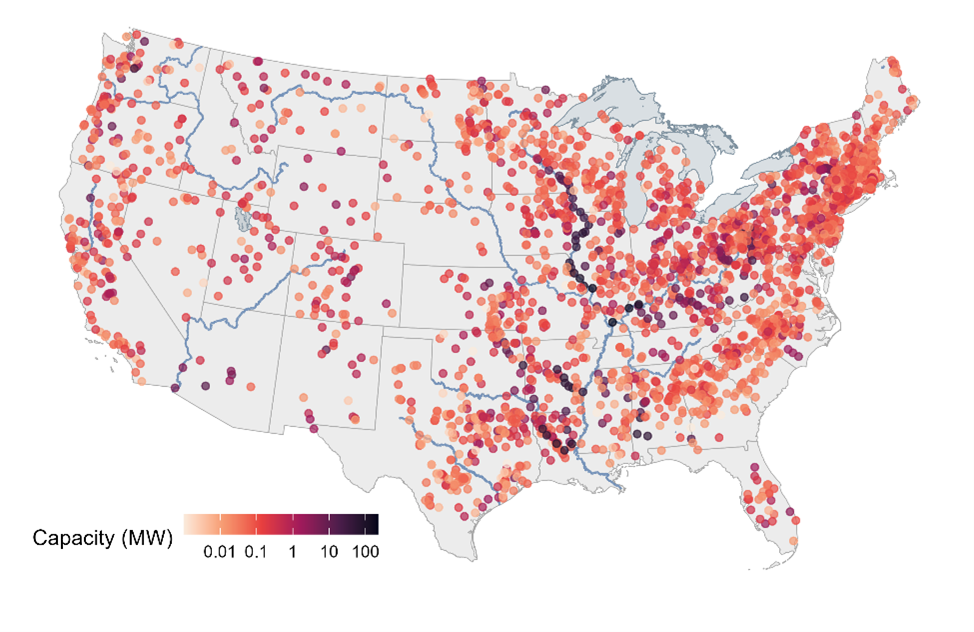
Citation
2024. Technical Potential for Hydropower Capacity at Non-powered Dams. Oak Ridge National Laboratory, Oak Ridge, Tennessee, USA. DOI: 10.21951/HydroCapacity_NPD/2570407
Overview
In the last decade, retrofits of existing nonpowered dams (NPDs) have made up the largest share of capacity increases for US hydropower. Accurate estimates of potential capacity and generation at NPDs help identify sites that may be worth investing in detailed feasibility analyses and design exploration. This dataset contains estimates of technical potential capacity and generation at 2,616 NPDs in the conterminous US. This is based on a subset of dams that were found by earlier resource assessments to have at least 100kW of theoretical potential. Historical daily streamflow (modeled or from USGS gauge records) and hydraulic head (based on historical observations or primary purpose and dam height) are the main inputs to the HydroGenerate model, which determines design flow, turbine efficiencies, and assumed friction losses and then calculates nominal capacity, daily generation, and capacity factor. These estimates represent the conditions over the historical period of 1980-2015, and are summarized on a monthly basis (i.e., averaged for each month of the year) and overall (i.e., nominal capacity, average annual generation (MWh), and average annual capacity factor). A total of nearly 4 GW capacity is estimated across all 2,616 NPDs included in the dataset.
This dataset was developed to support the Water Power Technologies Office project: Nonpowered Dam Resource Assessment Update.
Methods
Data were acquired from the NID (USACE, 2024), and subset based on estimated hydropower potential from the 2012 resource assessment (Hadjerioua et al, 2012) and spatial proximity to the National Hydrography Dataset, medium resolution network (NHDPlusV2). Design flow was determined as the 30% exceedance flow based on historical modeled streamflow data (Ganesh et al, 2024) or observed streamflow records from USGS gages. Turbine type, efficiency, and nominal capacity were then calculated, along with a daily time series of estimated generation. Finally, capacity factor was determined on a daily basis (daily generation compared to the 24-hour generation at design capacity). All of these values were summarized on a monthly and annual basis.
References
Ganesh R. Ghimire, Shih-Chieh Kao and Sudershan Gangrade. 2024. Dayflow: CONUS Daily Streamflow Reanalysis, Version 2. HydroSource, Oak Ridge National Laboratory, Oak Ridge, Tennessee, USA. https://doi.org/10.13139/OLCF/2222888
Hadjerioua, B., Wei, Y. and Kao, S.C., 2012. An Assessment of Energy Potential at Non-Powered Dams in the United States. GPO DOE/EE-0711, Wind and Water Power Program, Department of Energy, DC.
USACE. 2024. National Inventory of Dams. Retrieved February 23, 2024. Available at https://nid.usace.army.mil/#/downloads
Keywords
Science Themes
Related Records
US Hydropower Potential from Existing Non-powered Dams (greater than 1MW)
This dataset is a list of U.S. Existing Non-powered Dams (NPD) with hydropower potential greater than 1MW and consists of geo-referenced digital data and associated attributes.
View DatasetExisting Hydropower Assets (EHA) Plant Database, 2022
The Existing Hydropower Assets (EHA) Plant Database is a geospatially comprehensive point-level dataset containing locations and key characteristics of U.S. hydropower plants that are currently operational.
View DatasetHydroFish: Freshwater Fish Co-occurrence with Hydropower Plants and Non-Powered Dams in Conterminous United States Sub-basins
The HydroFish dataset lists all existing hydropower plants (EHA) and non-powered dams (≥ 0.001 MW potential nominal capacity), delineates the hydrologic sub-basins in which they are situated, and then lists all freshwater fish species reported to occur in those sub-basins.
View Dataset